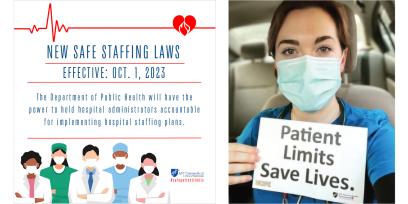Connecticut’s staffing legislation went into effect October 1, 2023, and we’ve been making great progress on our Code Red campaign goals.* We have established stronger staffing committees in all eight acute care hospitals that we represent. We’re training committee members on how to participate in meetings and what the committees and staffing plans should look like under the new law. We’re also educating our members more broadly about the legislation. We created a Safe Patient Limits toolkit (visit aftct.org/safe-patient-limits-toolkit) with webinars and additional resources, and we’re working with the AFT on a national webinar series on staffing committees, including how to use the committees for internal organizing.
We’ve also been working to ensure that hospitals abide by the legislation. The first staffing plans under the new law were submitted to the state on January 1. At five of our hospitals, the administration submitted the plans that our committees developed, voted on, and approved. At the other three hospitals, the administration refused to submit the committee-approved plans to the state. Instead, perhaps thinking they could get away with subverting the law, they submitted separate plans that had not been approved by the committees. In one of these, Backus Hospital, the meeting minutes that are available to everyone clearly show that the plan passed by the committee is not what the hospital submitted.
Hospitals that violate the law by not meeting their approved staffing numbers 80 percent of the time will face penalties beginning this October, but they must adhere to the other parts of the law—like posting the committee-approved staffing plan—now. So, we filed complaints against these three hospitals with the Connecticut Department of Public Health (DPH), the agency enforcing the legislation. Our staffing committee labor co-chair submitted the committee-approved plans to DPH, and it is investigating.
We know that DPH will want us to work this out with management at each hospital. However, these managers are trying to manipulate their way into the ratios that they mistakenly believe are good for their bottom lines. In meetings, they say things like, “This will cause backups in the emergency waiting room; how would you feel if that was your family?” This is not a capacity issue. Proper staffing ratios improve safety, patient outcomes, and nurse recruitment and retention—and research shows they are good for the bottom line.† Unless we force hospitals to staff at levels at which nurses feel safe and able to give patients the care they deserve, nurses will continue to be pushed out of the profession. Our members have pushed back, and we have the majority vote, so we hope DPH will back us up. If it doesn’t, we have enough friends in the legislature and in the governor’s office to address that.
This year, we are also working on workplace violence, another issue that ties into recruitment and retention. There was a horrible incident in October 2023, when a visiting nurse was murdered during a home visit. There have been other situations where the home care assignment was in a dangerous neighborhood. We’re lobbying for greater safety measures for our members that include and go beyond adequate staffing. We need a way to assess potential risks and flag those in patient charts. We also want wider access to the hands-on de-escalation training that tends to be only available for staff in the emergency or psychiatric departments. It should be required for anyone who interacts with patients, whether in clinical or support capacities.
We’re working with a coalition that includes the Connecticut Nurses Association, other unions in the state, and interested legislators to strengthen Connecticut’s existing staff safety legislation. Additionally, Joe Courtney, one of our congressmen, has been working on an Occupational Safety and Health Administration standard for workplace violence for years. We are cautiously optimistic that we may get that standard this year.
This Code Red campaign has been an incredible internal organizing tool. Our staffing committees have really owned our new legislation, and we’re going to keep communication channels open so that we know what’s going on at the different hospitals and can learn from each other. Many Connecticut hospitals are still not unionized. My hope is that through this campaign they see what can happen when people are empowered to use their collective voice—and that they’ll join us so they can make a difference in their hospitals too.
John Brady, RN, is the vice president of AFT Connecticut, an executive board member of the Connecticut AFL-CIO, and the former president of the Backus Federation of Nurses. He retired from Backus Hospital after 16 years as an emergency department nurse.
*For an introduction to Connecticut’s Code Red campaign and new staffing legislation, see “Winning Landmark Legislation for Connecticut Nurses” in the Fall 2023 issue of AFT Health Care. (return to article)
†To learn more, see “Patient Outcomes and Cost Savings Associated with Hospital Safe Nurse Staffing Legislation” by Karen Lasater et al. in BMJ Open: pubmed.ncbi.nlm.nih.gov/34880022. (return to article)
[Photo: Courtesy of AFT Connecticut]

